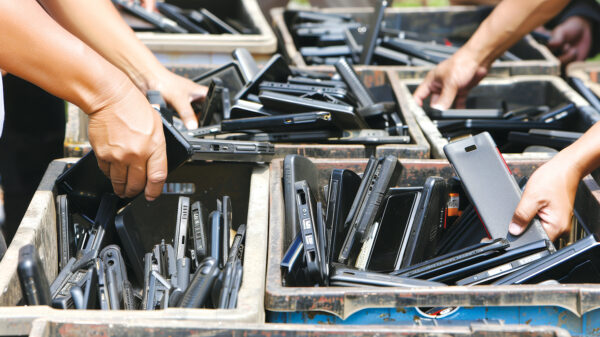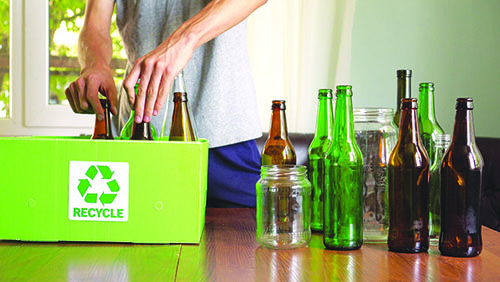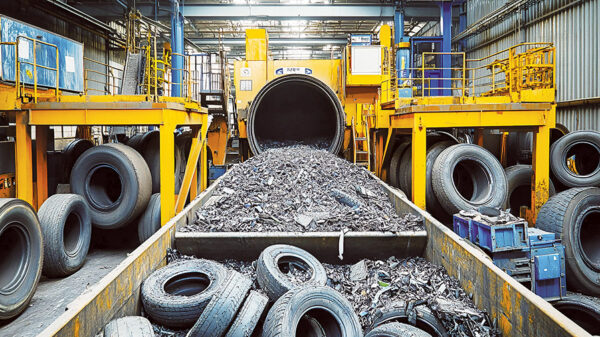From chemical processing of recycling plastics to eliminating single-use plastics to developing biodegradable polymers, the plastic recycling industry is facing continuous change and innovation. While progress is being made, the recycling rate of post-consumer plastic (or lack thereof) is startling. The Department of Energy released a study in 2022 that analyzed plastic recycling data and it found that only five percent of plastics are recycled, which matched a report by Beyond Plastics and the Last Beach Cleanup that indicated the recycling rate for post-consumer plastic was just five to six percent in 2021. While plastics recycling is on the decline, the per capita generation of plastic waste has increased by 263 percent since 1980.
The scale and impact of plastic pollution on the environment and human well-being has now been widely recognized. “‘Recycling’ as sub-category to the broader theme of ‘sustainable polymer engineering’ has become the topic of national academic center-scale research efforts and focus of industrial efforts,” said Michael Bockstaller professor, Materials Science and Engineering, Carnegie Mellon University College of Engineering. “The vision of a circular polymer economy has become more realistic. At the same time, after rapid initial progress and associated euphoria there is recognition that there are few but important problems for which no easy solution is available. It will take concerted and perhaps longer-term research efforts before polymer recycling can become ubiquitous.”
As Bockstaller explained, the biggest challenge facing the plastics recycling environment is in the separation of different polymer components from composite packages to attain pure recycle feedstock for reprocessing.
Two fundamental challenges:
- Polymers do not like to mix. Polymer products therefore consist typically of only one material (e.g., LDPE for plastic bags, PET for water bottles, etc.). Before recycling and reuse, the different plastic types have to be isolated and separated.
- While separation is straight forward for certain products, many materials used in food packaging are sophisticated composite materials, featuring different layers or different components serving different purposes. Separating out the different layers remains a bottleneck.
“Progress is happening through the concerted advances on many levels,” Bockstaller said. These include the development of biodegradable and natural-sourced polymers; the development of refined separation and recycling techniques, including machine-learning enabled recognition and separation of components; and the development of “chemical breakdown and re-use” strategies.
“The latter development is particularly intriguing. The idea is to reverse-engineer polymers, to revert the polymer back into its monomer form,” Bockstaller said. In this state, the different components can readily be separated, and new polymers can be made with even better properties (as compared to established recycling that results in a gradual loss of properties). Carnegie Mellon researchers are at the forefront of this development.
“My group is pursuing yet another strategy: the development of polymers that can ‘heal’ themselves,” Bockstaller said. “The idea is to design materials that can recover their structure and properties after damage events – thus reducing the amount of material that is discarded due to malfunction.”
While strides are being made in regard to improving the recyclability of plastics materials, Bonnie Monteleone, founder and executive director at the Plastic Ocean Project said that the landscape of plastic recycling today is
unsystematic.
“While recyclers try to create markets for materials to be kept in a circular economy, preventing more landfill waste and reducing extraction of new materials from the environment, the system is fraught with mixed messaging, blatant greenwashing and eroding trust in the system,” Monteleone said.
For instance:
- Recycling labels lack uniform standards and transparency in verification making it difficult for recyclers to identify the types of plastics.
- The mandatory requirement for putting the “chasing arrow” recycle symbol on most plastics gives the illusion that all plastics are recyclable, but truthfully, most plastics do not have a market to sell the recycled content. When consumers put all types of plastics in their recycle bin, the non-marketable recycled plastics become contaminants undermining the streamline for plastics that are recycled. Adding to the plastic recycling market challenge is the failed commitments of many companies pledging to incorporate more recycled materials.
- The introduction of biodegradable/compostable plastics into the waste stream inadvertently get mixed in with recycled plastic, lessening the quality of the recycled product.
Overcoming Obstacles
Montelone stressed that the plastic recycling industry faces three major hurdles:
- Economic Disparity: “Virgin” plastic, or new plastic, is more often cheaper than recycled plastics, despite having a higher carbon footprint.
- Complexity of Chemical Composition: The vast array of chemicals allowed in plastics complicates the recycling process significantly. This diversity makes it challenging to effectively recycle plastics.
- Lack of Demand: There is insufficient demand for recycled plastic, creating few financial incentives for people to engage in recycling. Whether it’s sorting materials, transporting them to markets, or purchasing products with recycled content, the financial motivation is lacking. This disparity highlights a disconnect between production and recovery infrastructure.
“Despite offering valuable services to society such as reducing greenhouse gas emissions, conserving energy, reducing extraction of natural materials, minimizing waste, and extending landfill space, recyclers are not fully recognized and valued for their contributions nor financially subsidized which would level the playing field,” Montelone said.
In addition, some recyclers turn to chemical recycling of plastics but, as Montelone explained, this form of recycling is not economically viable (i.e., it’s energy intensive and still requires a pretty clean stream of recycled plastics, void of any contaminants).
“But given the number of legacy materials containing toxic additives, we need to deploy technology to decommission toxic materials,” Montelone said. “Some form of conversion technology is needed.”
Steps Being Taken
There are some initiatives being taken to offset the decline of recycling of plastics. As Montelone pointed out, a chorus is forming to push policy such as container deposits, extended producer responsibility, and minimum content legislation. Many groups formerly opposed to policy are expressing a need for smart policy to address the challenges and stimulate progress. Recycling rates have been stagnant for decades and we can’t keep doing the same thing expecting different results.
“New materials are being produced to move away from plastic packaging,” Montelone said. For example, Atlantic Packaging is a packaging company seeking materials produced that work with nature, like fiber packaging that can decompose or be recycled much more readily. In an interview with chief executive officer Wes Carter, he explained to Montelone that as a packaging company, it is best to divert away plastic through the companies that sell packaging because by the time it gets to the consumer, it is too difficult to manage.
“Ultimately we need to encourage more transparency and accountability across all materials. Every material has trade-offs,” Montelone said. “We need a ‘North Star’ policy that encourages the use of materials with the lowest environmental footprint.”
And while technological advancements in terms of sorting processes has impacted the plastics recycling industry, in most cases the challenge is more economical in nature than technological.
“There are great examples of collaboration emerging. Circularity requires collaboration to move who markets toward properly designed materials and demand for recycled products,” Montelone said.
Sourcing Solutions International (SSI), for example, is a supplier that manufactures both hangers and packaging for the apparel/retail industry. SSI has production in China, Bangladesh, Vietnam, Indonesia, Cambodia, India and El Salvador.
“Plastic recycling still plays a vital role in the industry today,” said Joseph Schlossberg, vice president of global sales at SSI. “We are constantly using recycled plastics to make our hangers. Today you have materials such as Global Recycling Standard (GRS) plastic. This plastic is tracked and verified for its recycled content. So instead of saying you are using recycled materials, this verifies and confirm exactly where that material came from.” SSI has also been buying hangers, grinding them down, and making new pellet to use in its production.
Schlossberg said the biggest challenge facing the industry is the increased push to eliminate plastics in their entirety. “If less plastic is being used, then less plastic is available to recycle.” Another big challenge he is seeing is that the end consumer typically does not follow recycling standards.
“Most consumers are throwing a hanger in their garbage bin rather than recycling them properly,” Schollberg said. “This becomes an issue when these hangers end up sitting in a landfill where the plastic will take decades to break down.” He pointed to some initiatives to remove the single use of plastics with programs such as the GRS, which helps find a way to use a verified recycled plastic material in their production and manufacturing processes. In addition, many consumers are not ready to take the jump to a paper hanger counterpart, so it’s important that programs like GRS are available to help brands hit their sustainability goals.
“As much as we need to slow down the use of plastic, we cannot rely on fiber to replace all plastics,” Montelone said. “We need a circular economy based on waste, all waste, because most of it has value but markets must be supported. Taxing virgin plastics to elevate the market for recycled content will level the playing field and through this one change, unlock innovation in terms of markets and technology.”







